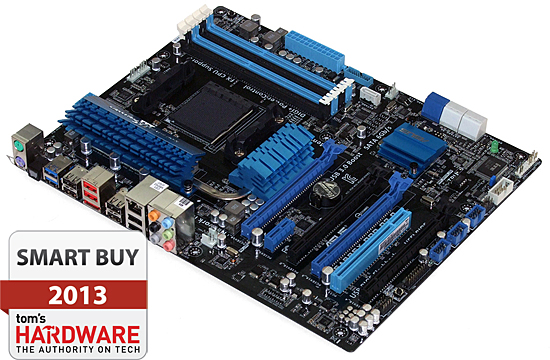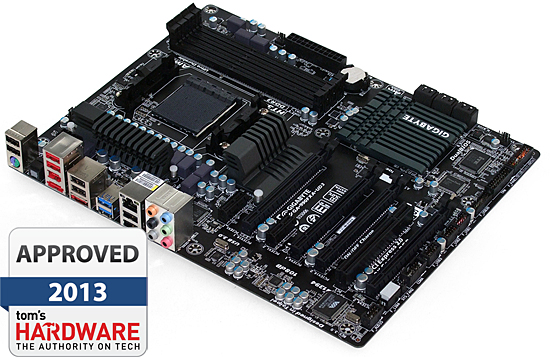Three AMD 990FX-Based Motherboards For Enthusiasts
AMD’s flagship FX-series processors squarely target enthusiasts with sub-$1,000 system budgets, and it's hard to get there with an expensive motherboard. We requested every vendor's top-value solution, and received three boards for your consideration.
Who Wins This Three-Way 990FX Comparison?
Today’s test is a little different than our usual process in that we went ahead and used each company's bundled management software at its default settings, allowing some of the value added to each board's bundle to show through. ASRock's board comes the closest to a traditional "clean" install, since its IES technology is turned off by default. Asus takes an approximate 1% performance hit, but doesn't appear to get any efficiency benefit. And Gigabyte's firmware nudges storage performance down slightly.
ASRock also offers the most features, and if you need those features, they might be worth the extra $22 shown in the chart, compared to Gigabyte’s 990FXA-UD3. The problem is that the chart represent last week's prices, and we haven't a clue what will happen next week. The best ASRock can hope to accomplish is an occasional value-tie to Gigabyte, and that didn't happen today. Whether or not Gigabyte and ASRock achieve a value tie appears to depend on the day of the week you look at their prices.
Update, 4/3: ASRock tells us that the 990FX Extreme9 is now listed for $160 again on Newegg. This price will be held until the end of April. For $30 less than this board was originally reviewed, its feature set becomes much more attractive, and more in-line with the value message of AMD's FX processors.
The tightest competition comes down to Asus' M5A99FX Pro R2.0 and Gigabyte's 990FXA-UD3. Gigabyte enjoys a slight advantage in the performance-per-dollar race, while Asus' big lead is in memory overclocking. At the same time, Asus takes a big loss in idle power consumption, but compensates with a big win in full-load power draw. And if we diminished most of those power differences by not installing Asus' power management software at default settings, the company would have likely matched the performance of Gigabyte and ASRock.
Gigabyte has the benefit of FireWire ports, which most users no longer need. Asus has the benefit of USB BIOS Flashback, which isn't needed very often either, but is a real lifesaver when you figure out an update is necessary to support that new processor you just bought. Asus bundles a better application suite to complement a longer list of exclusive features. Then again, we think Asus needs those extras to justify the M5A99FX Pro R2.0’s $5 premium over the Gigabyte board. The company succeeds in this. And, with overall value balanced, we cast our vote in favor of the better overclocker.
Our Smart Buy award applies to folks who put in the effort to configure Asus' power management software to their perfect preferences or, alternatively, the purists who'd prefer not to install it at all. The utility's default settings simply were not beneficial in our tests.
We know that some of those same purists will object, pointing out that they won't install any of Asus' value-added software anyway, will do their research before buying a processor that might not be supported out of the box, and don't plan on using extraordinarily fast DDR3 memory. They'll tell us they're better off saving $5, keeping FireWire connectivity, or adding an expansion card to its extra single-lane PCI Express slot. Because those enthusiasts have their own specific needs, they already know they're right. Our next award is proof that $5 saved is $5 earned, and recognition that Gigabyte's 990FXA-UD3 is still a solid, well-priced product that does its job well.
Get Tom's Hardware's best news and in-depth reviews, straight to your inbox.
Current page: Who Wins This Three-Way 990FX Comparison?
Prev Page Power, Heat, And Efficiency-
designasaurus "if we diminished most of those power differences by not installing Asus' power management software at default settings, the company would have likely matched the performance of Gigabyte and ASRock."Reply
Don't speculate! Do the tests and add it to the article so we can see what the software packages are actually accomplishing! That's why I read your site, yeah? For hard info that I can't get myself. -
bgunner designasaurus"if we diminished most of those power differences by not installing Asus' power management software at default settings, the company would have likely matched the performance of Gigabyte and ASRock."Don't speculate! Do the tests and add it to the article so we can see what the software packages are actually accomplishing! That's why I read your site, yeah? For hard info that I can't get myself.I totally agree with this statement. The test should have been done and added into the article because this would of been a good representative of the value of the software. I would like to know for a fact if the software was a hindrance to the electrical efficiency of the Asus and Gigabye boards.Reply -
Crashman bgunnerI totally agree with this statement. The test should have been done and added into the article because this would of been a good representative of the value of the software. I would like to know for a fact if the software was a hindrance to the electrical efficiency of the Asus and Gigabye boards.At least the power was measured and mentioned, even if it didn't get into the chart.Reply
-
bit_user AMD's 890FX was an excellent low-cost server platform, in its day. Great I/O, tons of PCIe lanes, 6-channel SATA3, and ECC support. All with boards and CPUs in the desktop price range that were close to being performance competitive with Intel (when they were introduced, at least).Reply
Now, AMD is just slipping too far behind. Not just on the CPU front, but like how about some PCIe 3?
I'm waiting for 64-bit ARMs to hit the desktop. That's probably the next truly interesting thing on the horizon.
-
boulbox Reply10596062 said:Aren't the 990FX chipsets kind old?
Yes, but not a lot of new things need to be offered anyways. PCIe 3.0 is just a gimmick and doesn't really give much more performance over PCIe2 -
Crashman falchardAren't the 990FX chipsets kind old?990FX is AMD's current "high-end" chipset for enthusiast-level desktops. AMD occasionally releases new chips (look last fall) and motherboard companies keep updating their selection of products.Reply
Old chipset, recent boards, any questions?
-
darkchazz "Three AMD 990FX-Based Motherboards For Enthusiasts"Reply
I don't think enthusiasts would want to buy a slow CPU from AMD. -
Onus What did I miss? The ASRock has better features, including 3-way SLI, more USB3.0, an abundance of accessories, uses less power (the only positive efficiency), has higher performance, lower VRM temps; but BOTH of the other two got awards? I noted the comment about fluctuating prices, but on features alone ASRock looks like the winner. Surely it wasn't the slightly lower OC...Reply



